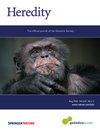Deforestation-induced Hybridization in Philippine Frogs Creates a Distinct Phenotype With an Inviable Genotype
IF 3.9
2区 生物学
Q2 ECOLOGY
引用次数: 0
Abstract
Hybridization plays a major role in the evolutionary history of many taxa and can generate confounding patterns affecting many downstream applications. In this study, we empirically demonstrate how hybridization obfuscates phylogenetic inference (via the artefactual branch effect), species boundaries, and taxonomy in an adaptive radiation of frogs. Philippine narrow-mouthed frogs of the genus Kaloula exhibit a wide range of phenotypic and ecological adaptations but their evolutionary history and taxonomy remain poorly understood. In particular, the Kaloula conjuncta complex contains numerous subspecies with unresolved taxonomic boundaries and unclear evolutionary relationships. Within this complex, Kaloula conjuncta stickeli, until now was considered a rare, enigmatic, and phenotypically distinct subspecies that had not been encountered since its original description nearly 80 years ago. Here, we show that K. c. stickeli shares alleles with K. conjuncta meridionalis and another species outside the conjuncta group, K. picta. Using target-capture sequencing and a robust analytical framework, we show that despite having a unique phenotype, K. c. stickeli is likely an inviable F1 hybrid between K. c. meridionalis and K. picta and thus, does not warrant taxonomic recognition. Our results show how industry-standard approaches in systematic inference and integrative taxonomy—morphological, phylogenomic, clustering, and distance-based methods—can generate misleading results for identifying and understanding affinities of hybrids. In contrast, we demonstrate how network multispecies coalescent and population genetic approaches are more effective at accurately inferring reticulated evolutionary history. We also propose a rare phenomenon of deforestation-induced hybridization, which could have important consequences in light of large-scale Southeast Asian forest destruction.

毁林诱导的菲律宾青蛙杂交产生了一种独特的表型和一种不可存活的基因型。
杂交在许多分类群的进化史中起着重要作用,并可能产生影响许多下游应用的混淆模式。在这项研究中,我们通过经验证明了杂交如何混淆系统发育推断(通过人工分支效应)、物种边界和青蛙适应性辐射的分类。菲律宾狭口蛙的Kaloula属表现出广泛的表型和生态适应性,但他们的进化历史和分类仍然知之甚少。特别是,Kaloula结膜复合体包含许多亚种,这些亚种的分类界限和进化关系尚未确定。在这个复杂的群落中,直到现在,卡卢拉(Kaloula conjuncta stickeli)一直被认为是一种罕见的、神秘的、在表型上独特的亚种,自从它在近80年前被描述以来,还没有遇到过。本研究表明,刺毛大蠊与子叶大蠊和结膜组外的另一种大蠊具有相同的等位基因。利用目标捕获测序和强大的分析框架,我们表明,尽管具有独特的表型,但kc . stickeli可能是kc . meridionalis和kk . picta之间不可存活的F1杂交,因此不能保证分类识别。我们的研究结果表明,系统推断和综合分类的行业标准方法——形态学、系统基因组学、聚类和基于距离的方法——如何在识别和理解杂交亲缘性方面产生误导性的结果。相反,我们证明了网络多物种聚结和群体遗传方法如何更有效地准确推断网状进化历史。我们还提出了一种罕见的毁林诱导杂交现象,这可能对东南亚大规模森林破坏产生重要影响。
本文章由计算机程序翻译,如有差异,请以英文原文为准。
求助全文
约1分钟内获得全文
求助全文
来源期刊

Heredity
生物-进化生物学
CiteScore
7.50
自引率
2.60%
发文量
84
审稿时长
4-8 weeks
期刊介绍:
Heredity is the official journal of the Genetics Society. It covers a broad range of topics within the field of genetics and therefore papers must address conceptual or applied issues of interest to the journal''s wide readership
 求助内容:
求助内容: 应助结果提醒方式:
应助结果提醒方式:


